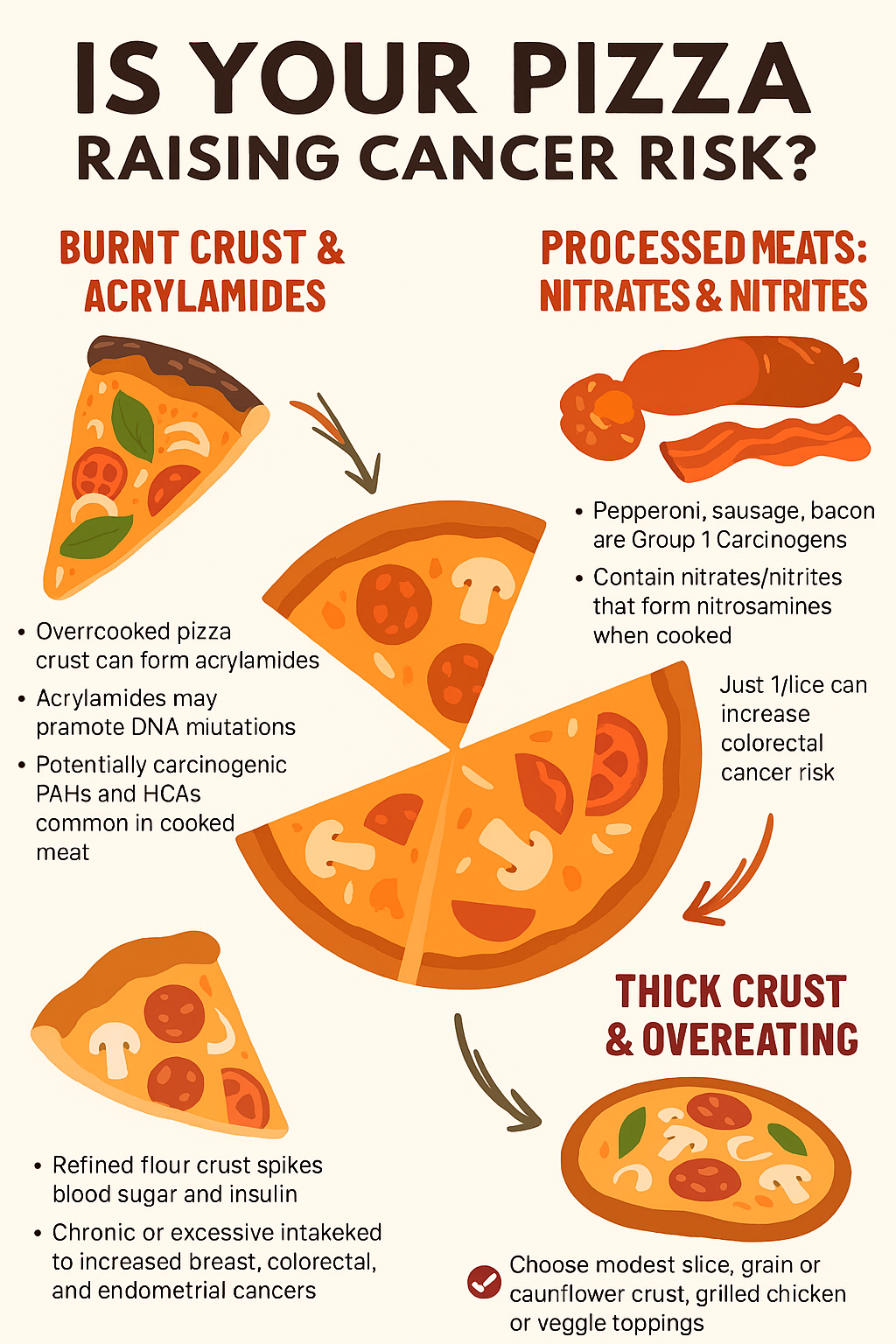🍕Is Your Pizza Raising Your Cancer Risk?
Pizza’s dark side: burnt crust, processed meats, and blood sugar spikes can raise cancer risks—here’s what the science says.
Written by Keith Bishop, Integrative Cancer Educator, Clinical Nutritionist, Retired Pharmacist, and Founder of Prevail Over Cancer.
🔥Burnt Crust and Acrylamides: A Carcinogenic Combo?
When pizza crust is overcooked or charred, it can form acrylamides—chemical compounds linked to increased cancer risk. Acrylamides are especially prevalent in carbohydrate-rich foods cooked at high temperatures, such as baked goods and fried potatoes. Though research is ongoing, acrylamides are genotoxic (damage DNA) and carcinogenic in animal studies.
Additionally, the blackened edges of pizza crust may contain polycyclic aromatic hydrocarbons (PAHs) and heterocyclic amines (HCAs), both of which are formed during high-heat cooking and have been shown to damage DNA and promote cancer development.[i]
Learn more from the National Cancer Institute: Chemicals in Meat Cooked at High Temperatures and Cancer Risk

Most commercial pizza ovens operate between 600°F and 900°F, depending on the type of oven and style of pizza being made.
Here’s a breakdown of common commercial oven types and their temperature ranges:
🔥Typical Temperature Ranges by Oven Type
|
Oven Type |
Temperature Range |
Notes |
|
Wood-fired ovens |
850°F–900°F |
Ideal for Neapolitan-style pizza; cooks in ~90 seconds |
|
Gas/electric deck ovens |
500°F–700°F |
Common in pizzerias; slower cook time, crispier crust |
|
Convection ovens |
450°F–600°F |
Uses fans for even cooking; less common for artisan pizzas |
|
Rotating ovens |
600°F–800°F |
Efficient for high-volume operations |
Sources: The Restaurant Authority, Bacinos Pizza Guide
These high temperatures are essential for achieving the signature texture—crispy exterior, chewy interior—while minimizing sogginess. However, they also contribute to the formation of acrylamides, HCAs, and nitrosamines when crusts are burnt or when processed meats are cooked at extreme heat, which directly ties into cancer risk concerns.
Processed Meats: Nitrates, Nitrites, and Nitrosamines
Popular pizza toppings like pepperoni, sausage, ham, and bacon are classified as Group 1 carcinogens by the World Health Organization. These meats often contain nitrates and nitrites, preservatives that can form nitrosamines—potent carcinogens—when heated to high temperatures during cooking.[ii]
Studies show that consuming just 50 grams of processed meat daily (about two slices of bacon or one hot dog) can increase colorectal cancer risk by 18%.[iii] Nitrosamines have also been implicated in stomach and pancreatic cancers, especially when combined with smoking or alcohol consumption.
🔗 Tufts Health & Nutrition Letter explains more: Processed Meats and Cancer
Prevail Over Cancer™
Click Here 👉🍕Cancer-Smart Pizza Guide
How to Choose Safer Crusts, Toppings, and Cooking Methods
🍞Thick Crust and Overeating: Blood Sugar and Insulin Spikes
Pizza’s refined-flour crust—especially when thick or consumed in excess—can cause rapid spikes in blood glucose and insulin levels. Chronically elevated insulin levels are associated with increased cancer risk, particularly for breast[iv], colorectal[v], glioblastoma[vi], prostate cancer[vii], pancreatic cancer[viii], lung cancer[ix], ovarian cancer[x], and endometrial cancers[xi].
High-glycemic-load diets may promote inflammation and oxidative stress, creating a metabolic environment conducive to tumor growth. For cancer survivors and those at risk, limiting refined carbs and portion sizes is a key dietary strategy.
✅Smart Swaps and Safer Slices
Here’s how to enjoy pizza more safely:
- Choose whole-grain or cauliflower crusts to reduce acrylamide formation and glycemic load.
Amazon Link to Almond Flour Crust Pizza Mix: https://amzn.to/49nVA0c - Avoid burnt edges and opt for a lightly baked crust.
- Limit processed meats—try grilled chicken, mushrooms, or veggies instead.
- Watch portion sizes—one or two slices with a side salad is better than half a pie.
🧠Final Thoughts: Pizza Isn’t Evil, But It’s Not Innocent
Pizza can be part of a balanced diet, but its typical ingredients and cooking methods pose real risks when consumed frequently or excessively. By understanding the science and making strategic swaps, you can enjoy your slice without compromising your health.
Pizza Cancer Reference Sources
[i] National Cancer Institute. Chemicals in Meat Cooked at High Temperatures and Cancer Risk. National Cancer Institute. Published July 11, 2017. https://www.cancer.gov/about-cancer/causes-prevention/risk/diet/cooked-meats-fact-sheet
[ii] Staff E. Processed Meats and Cancer: It’s Not Just Nitrates - Tufts Health & Nutrition Letter. Tufts Health & Nutrition Letter. Published December 13, 2018. Accessed October 29, 2025. https://www.nutritionletter.tufts.edu/healthy-eating/processed-meats-and-cancer-its-not-just-nitrates/
[iii] Crowe, W., Elliott, C. T., & Green, B. D. (2019). A Review of the In Vivo Evidence Investigating the Role of Nitrite Exposure from Processed Meat Consumption in the Development of Colorectal Cancer. Nutrients, 11(11), 2673. https://doi.org/10.3390/nu11112673
[iv] Makwana, S. H., Poswal, J., Yadav, P., Singh, S. P., & Mandal, C. C. (2025). Unexplored gene PHKA1 interplays between glucose metabolism and breast cancer. Biochimica et Biophysica Acta (BBA) - Molecular Cell Research, 1872(8), 120052. https://doi.org/10.1016/j.bbamcr.2025.120052
[v] Shin, H. G., Yunn, N., Kim, J. W., Cho, Y. B., Ryu, S. H., Shim, H., & Lee, S. (2025). Intrabody targeting of insulin receptor pY1150: A novel approach to modulate signaling pathways in colorectal cancer cells. Cellular Signalling, 136, 112143. https://doi.org/10.1016/j.cellsig.2025.112143
[vi] Laviv Y, Sapirstein E, Kanner AA, et al. Significant Systemic Insulin Resistance is Associated With Unique Glioblastoma Multiforme Phenotype. Clinical Pathology. 2023;16. Doi https://doi.org/10.1177/2632010x231207725
[vii] Wang J, An H, Tao N. Association of non-insulin-based insulin resistance indices, mean platelet volume and prostate cancer: a cross-sectional study. BMC Cancer. 2025;25(1). doi: https://doi.org/10.1186/s12885-025-13839-0
[viii] Stolzenberg-Solomon RZ. Insulin, Glucose, Insulin Resistance, and Pancreatic Cancer in Male Smokers. JAMA. 2005;294(22):2872. doi: https://doi.org/10.1001/jama.294.22.2872
[ix] Cho, I.Y., Chang, Y., Sung, E. et al. Glycemic status, insulin resistance, and mortality from lung cancer among individuals with and without diabetes. Cancer Metab 12, 17 (2024). https://doi.org/10.1186/s40170-024-00344-4
[x] Karimi, F., Dinarvand, N., Sabaghan, M. et al. Diabetes and ovarian cancer: risk factors, molecular mechanisms and impact on prognosis. Endocrine 83, 1–9 (2024). https://doi.org/10.1007/s12020-023-03477-6
[xi] Moshayedi, N., Clair, K., & Francoeur, A. A. (2025). Obesity management in the setting of endometrial cancer and hyperplasia: A narrative review. Gynecologic Oncology Reports, 61, 101929. https://doi.org/10.1016/j.gore.2025.101929



